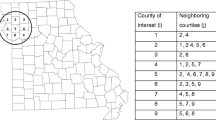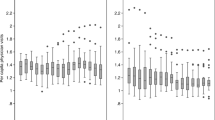Abstract
We developed a model to estimate out-of-hospital deaths due to Myocardial Infarction (MI), which was based on a detailed database of MI admissions to Pennsylvania hospitals during 1998. Our estimation method addresses the problem of geographical selection bias in inpatient databases, which occurs when MI patients with poor geographic access are undersampled. A Geographic Information System (GIS) was used to determine travel times between hospitals and patients, based on patients' zip code of residence. Nearness to a hospital was positively associated with in-hospital mortality (P<0.01) and emergency admissions (P<0.01) and negatively associated with out-of-hospital mortality (P<0.01). Model predictions were made for a range of input values and validated using empirical data.
Similar content being viewed by others
References
D. Dranove and A. Durac, Are multi-hospital systems more efficient? Health Affairs 15 (1996) 100-104.
M. Succi, S.Y. Lee and J. Alexander, Effects of market position and competition on rural hospital closures, Health Services Research 31 (1997) 679-699.
J. Leighty, Closing time: California leads nation in hospital closures, Nurseweek (1999).
American Heart Association, Heart attack and angina statistics, www.americanheart.org, date accessed: July 4, 2002.
J. Pell, J. Sirel, A. Marsden et al., Effect of reducing ambulance time on deaths from out-of-hospital cardiac arrest: Cohort study, British Medical Journal 322 (2001) 1385-1388.
J. Bachman, G. McDonald and P. O'Brien, A study of out-of-hospital cardiac arrests in northeastern Minnesota, JAMA 256 (1986) 477-483.
GUSTO Investigators, An international randomized trial comparing four thrombolytic strategies for acute myocardial infarction, New England Journal of Medicine 329 (1993) 673-682.
D. Earle, Half of heart patients die before reaching help, Reuters Health (February 14, 2002).
R. Gillum, Geographic variation in sudden coronary death, American Heart Journal 119 (1990) 380-389.
E. Sigurdsson, G. Thorgeirsson et al., Unrecognized myocardial infarction: Epidemiology, clinical characteristics and the prognostic role of angina pectoris, Annals of Internal Medicine 122 (1995) 103-106.
J. Baker, E. Clayton and B. Taylor, A non-linear multi-criteria programming approach for determining county emergency medical service ambulance allocations, Journal of Operational Research Society 40 (1989) 423-432.
P. Steen, A. Brewster et al., Predicted probabilities of hospital death as a measure of admission severity of illness, Inquiry 30 (1993) 128-141.
L. Iezzoni, Risk-Adjustment for Measuring Health Care Outcomes (Health Administration Press, Chicago, 1997).
Pennsylvania Department of Health, Pennsylvania Vital Statistics (1998).
D. Ingram and R. Gillum, Regional and urbanization differentials in coronary heart disease mortality in the United States, Journal of Clinical Epidemiology 42 (1989) 857-868.
L. Pickle, Atlas of United States Mortality (National Center for Health Statistics, MD, 1996).
M. Pozen, M. Berezin et al., Ambulance utilization by patients with acute myocardial infarction, American Journal of Public Health 68 (1978) 568-572.
D. Kleinbaum, L. Kupper et al., Applied Regression Analysis and Other Multivariate Methods (Duxbury, Boston, 1998).
J. Piette and R. Moos, The influence of distance on ambulatory care use, death and readmission following a myocardial infarction, Health Services Research 31 (1996) 573-591.
J. Christianson, Potential effects of managed care organizations in rural communities: A framework, The Journal of Rural Health 14 (1998) 169-179.
D. Farley and R. Ozminkowski, Volume-outcome relationships and inhospital mortality: The effect of changes in volume over time, Medical Care 30 (1992) 77-94.
H. Luft, S. Hunt and S. Maerki, The volume-outcome relationship: Practice-makes-perfect or selective referral patterns? Health Services Research 22 (1987) 157-182.
S. Maerki, H. Luft and S. Hunt, Selecting categories of patients for regionalization, Medical Care 24 (1986) 148-158.
D. Thieman, J. Coresh et al., The association between hospital volume and survival after acute myocardial infarction in elderly patients, The New England Journal of Medicine 340 (1999) 1640-1648.
R. Dudley, K. Johansen et al., Selective referral to high-volume hospitals: Estimating potentially avoidable deaths, JAMA 283 (2000) 1159-1166.
Author information
Authors and Affiliations
Rights and permissions
About this article
Cite this article
O'Neill, L. Estimating Out-of-Hospital Mortality Due to Myocardial Infarction. Health Care Management Science 6, 147–154 (2003). https://doi.org/10.1023/A:1024463418429
Issue Date:
DOI: https://doi.org/10.1023/A:1024463418429




